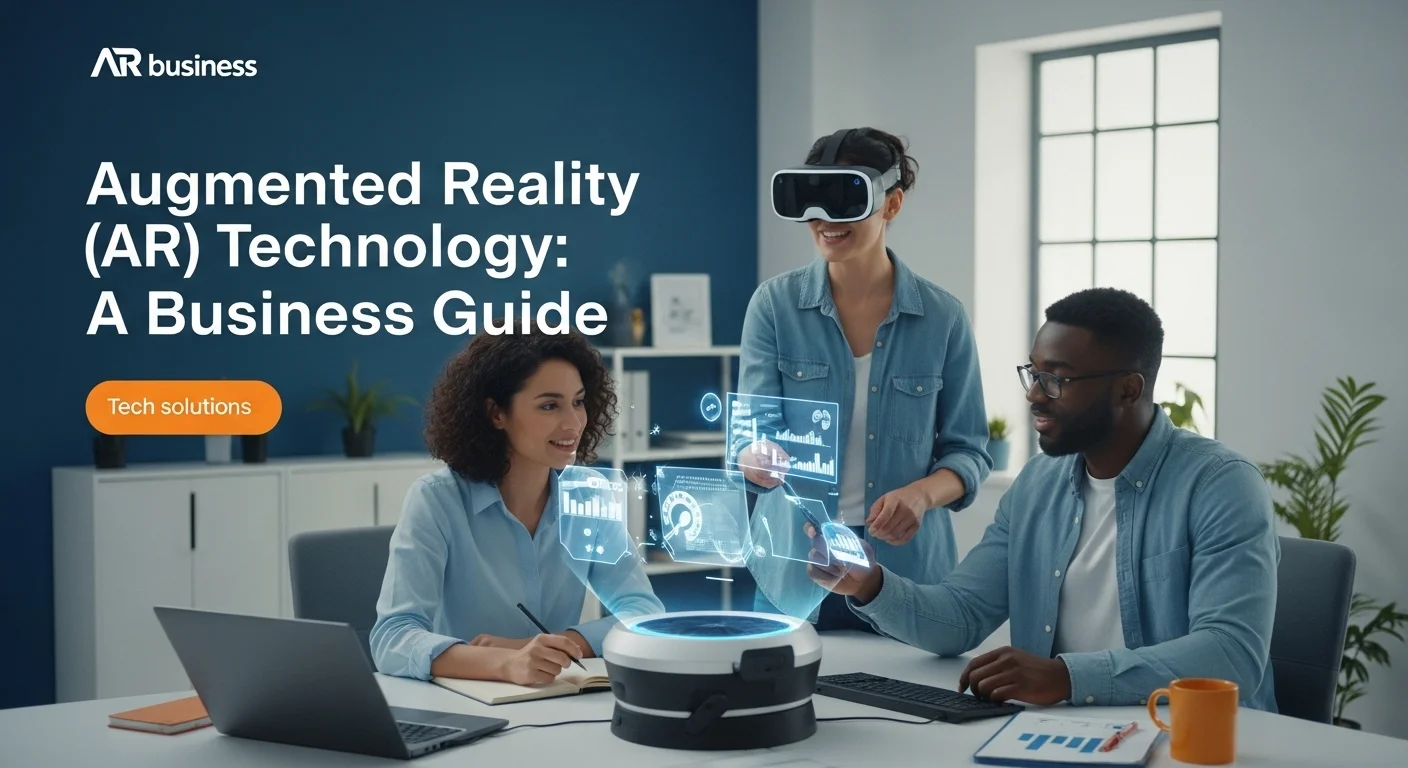Augmented Reality in Business: Your Practical Guide to AR

Executive Summary
I've watched Augmented Reality (AR) grow from a sci-fi dream into one of the most practical tools for businesses today. It's not just about gaming anymore; it's about fundamentally changing how we interact with the world. This article is my comprehensive guide to AR, based on years of seeing it implemented in the real world. We'll break down what AR is, how it's evolved, and its real impact on industries. We'll look at the hardware that makes it all possible, like today's advanced smart glasses and sophisticated headsets, and how they bring digital content into our reality. We'll touch on key players, from the evolution of Nreal (now XREAL) to the excitement around Apple's AR ecosystem. For business leaders, I'll unpack the real-world advantages of AR—how it can boost customer engagement, simplify complex manufacturing, and completely change employee training. We'll explore practical applications and development tools, giving you a clear roadmap to leverage the powerful world of augmented reality.
Table of Contents
What is AR and Why Does It Matter?
Augmented Reality, or AR, is a technology that overlays digital information—images, sounds, and text—onto our view of the real world. Think of it not as replacing reality, but enhancing it. I've always found that the best way to describe it is to imagine having a smart assistant that can place helpful data right where you need it. Unlike Virtual Reality (VR), which puts you in a completely different, digital world, AR keeps you grounded in your current environment. The magic happens through a device, usually your smartphone or a pair of smart glasses, which uses cameras and sensors to understand the space around you. In real-time, it has to map the environment, track your position, and render virtual objects so they look like they're actually there. It's a complex dance of hardware and software, but when it works, it feels incredibly natural.
The Evolution and Core Components of AR Technology
AR has been around in labs for decades, but it was the smartphone that really brought it to the masses. I remember when Pokémon Go came out; it was a huge 'aha' moment for the public. It showed millions of people the simple fun of AR. Behind the scenes, developers were getting powerful tools like Apple's ARKit and Google's ARCore, which made building sophisticated AR apps much easier. Now, the next big leap is happening with wearables. We're moving beyond holding a phone and toward hands-free devices. The development of lightweight ar glasses and more powerful ar headsets is where the real potential lies. These devices promise to seamlessly weave digital information into our daily lives. You see a wide range of hardware out there, from business-focused gear like the Microsoft HoloLens to consumer products. A key player has been Nreal (now XREAL), which has really pushed what's possible with consumer-friendly glasses that connect to your phone. And of course, the entire tech world is waiting to see what happens with the long-rumored Apple AR glasses, a product that could finally make augmented reality a mainstream, everyday experience, building on the solid foundation of the Apple AR ecosystem and the new Vision Pro.
Differentiating AR, VR, and Mixed Reality (MR)
To really get AR, it helps to understand how it differs from its cousins, VR and MR. As I said, VR shuts out the real world and immerses you completely in a digital one, perfect for gaming or virtual tours. AR adds to your world. Mixed Reality (MR) is the next step up from AR. While basic AR just overlays an image, MR allows virtual objects to truly interact with your environment. Imagine placing a virtual lamp on your real-life desk, and then being able to walk around it, with the lamp staying perfectly in place. The Microsoft HoloLens is a great example of an MR device. Honestly, the lines between AR and MR are blurring these days, as many systems now have MR-like capabilities. The ultimate goal for any advanced headset is to create a perfect MR experience where you can't tell the digital from the physical.
The Importance of AR in the Modern Business Landscape
AR is so much more than a gimmick; it's a game-changer for countless industries because it delivers the right information at the right time and place. This leads to huge gains in efficiency, accuracy, and safety.
Business and Enterprise Applications
I've seen AR make a massive difference firsthand in several sectors:
- Manufacturing and Engineering: Imagine a technician wearing a headset that overlays step-by-step repair instructions directly onto a piece of machinery. I've seen this cut down on errors and training time dramatically. The system highlights the exact bolt to turn, removing any guesswork.
- Healthcare: Surgeons can overlay 3D models of a patient’s organs from an MRI scan onto their body during surgery. It's like having X-ray vision, which can lead to incredible precision and better outcomes. Medical students also benefit by studying virtual anatomy instead of relying solely on cadavers.
- Retail and E-commerce: AR has transformed online shopping. I'm sure you've seen how IKEA's app lets you place virtual furniture in your living room. It's not just cool; it's practical. It helps you make a better decision and reduces product returns, which is a huge win for retailers.
- Logistics and Warehousing: A worker with smart glasses can get picking instructions right in their field of view. The glasses can highlight an item's location and show the fastest route to it, making the process faster and more accurate.
- Education and Training: AR brings learning to life. A student can explore a virtual solar system in their classroom or dissect a digital frog. In corporate training, it provides safe, hands-on simulations for complex or dangerous jobs, like training pilots or energy sector workers.
The Future is Wearable: AR Glasses and Headsets
The true future of AR is wearable. The real magic will happen when the technology is delivered through something as normal and comfortable as a pair of everyday glasses. This is the vision driving products like the potential Apple AR glasses. The goal is a device that's powerful, comfortable for all-day use, and socially acceptable.
The technical challenges are enormous—from optics and battery life to processing power and heat. Fitting a bright, transparent display with a wide field of view into a normal glasses frame is an incredible engineering feat. This is why we currently have two main categories: the sleeker ar glasses that tether to a smartphone for processing (like the XREAL models), and the more powerful, self-contained ar headsets (like the HoloLens), which are bulkier but far more capable.
The development of the Apple AR platform and its potential move into glasses is so significant because of Apple’s history of defining new product categories. Just like the iPhone and Apple Watch, an Apple AR device could be the catalyst that pushes augmented reality into the mainstream. It would create a massive ecosystem for developers and accelerate innovation everywhere. We're at a point where powerful hardware, smart software, and compelling use cases are finally coming together, setting the stage for AR to become one of the most transformative technologies of our time.

Complete guide to Ar in Technology and Business Solutions
Going deeper into Augmented Reality means getting your hands dirty with the technical methods, business strategies, and the hardware and software that make it all work. This is my guide to how AR solutions are actually built and deployed, offering a clear path for businesses wanting to get started. The landscape is full of incredible tools, and the hardware, from powerful headsets to stylish glasses, is improving at a dizzying speed. For any company, the first step is always to match the right AR approach to a specific problem and then choose the right tools for the job.
Technical Methods of Augmented Reality
AR isn't a single technology; it's a collection of methods. The one you choose depends entirely on what you're trying to accomplish.
- Marker-Based AR: This is one of the original and most reliable forms of AR. It uses a specific image, like a QR code or logo, as a trigger. When your app's camera sees the marker, it knows exactly where to place the digital content. It's very accurate and doesn't require a lot of processing power, making it perfect for things like interactive packaging or museum exhibits where you can place a physical trigger.
- Markerless AR: This is the tech behind most modern AR apps on your phone. It doesn't need a special marker because it uses complex algorithms to understand the world around it. It comes in a few flavors:
- Location-Based AR: This uses your device's GPS and compass to overlay information based on your geographic location. Pokémon Go is the classic example, but it's also great for virtual city tours or navigation apps.
- SLAM (Simultaneous Localization and Mapping): This is the powerhouse of modern AR. The device continuously builds a 3D map of its surroundings while tracking its own position within that map. This is what lets you place a virtual object on a real table and have it stay there as you walk around. It's the core technology in Apple's ARKit and Google's ARCore and is essential for any advanced headset or smart glasses.
- Projection-Based AR: This method projects light and images directly onto real-world surfaces. You don't need a screen or headset because the environment itself becomes the display. I've seen it used effectively in manufacturing, where lasers project assembly instructions right onto a part.
- Superimposition-Based AR: This technique replaces the original view of an object with an augmented one. For instance, a surgeon might see an X-ray view laid directly over a patient's body. It's also used in home renovation apps that let you 'paint' your walls a new color in real-time.
AR Development Platforms and SDKs
Thankfully, you don't have to build an AR app from scratch. There are amazing platforms and Software Development Kits (SDKs) that handle the hard parts, letting developers focus on the user experience.
- ARKit (Apple): Built into iOS, this is Apple's framework for AR. It's incredibly powerful and optimized for iPhones and iPads, making it the go-to choice for developing for the Apple AR ecosystem.
- ARCore (Google): This is Google's version for Android. It offers similar core features to ARKit, like motion tracking and environmental understanding.
- Unity: This is the dominant platform for building 3D experiences. It's not an AR platform itself, but it works seamlessly with ARKit, ARCore, and others. I'd say the vast majority of developers I know use Unity because of its powerful engine and flexibility.
- Unreal Engine: Known for its stunning, high-fidelity graphics, Unreal is another top-tier engine. It's a great choice when you need to create visually breathtaking and complex AR scenes.
- Vuforia: One of the veterans in the AR space, Vuforia is especially strong in enterprise and industrial applications. It has powerful features for recognizing objects based on their 3D models, which is invaluable in manufacturing.
Hardware Comparison: AR Glasses vs. AR Headsets
Choosing the right hardware is critical. It's a trade-off between power, portability, and price, and it all depends on the job you need it to do.
- AR Glasses (Consumer-focused): These are lightweight, stylish devices that often look like sunglasses. They usually connect to a smartphone, which does all the heavy lifting.
- XREAL Air (formerly Nreal): The Nreal AR glasses were pioneers in this space. They project a large, high-quality virtual screen in front of you, which is fantastic for watching movies or as a portable monitor. They're a perfect example of a display-focused, portable device.
- Ray-Ban Meta Smart Glasses: These don't have a visual overlay, so they aren't 'true' AR. But with built-in cameras and audio, they are a stepping stone toward integrating tech more seamlessly into eyewear.
- Speculative: Apple AR Glasses: The highly anticipated glasses from Apple are expected to be a lightweight device that relies on an iPhone, focusing on delivering notifications, navigation, and other quick bits of information right into your line of sight.
- AR/MR Headsets (Enterprise-focused): These are more powerful, self-contained computers you wear on your head. They're bulkier and more expensive but offer far more advanced capabilities.
- Microsoft HoloLens 2: This is the gold standard for enterprise use. With its advanced hand and eye tracking, it's a phenomenal AR headset for remote assistance, complex training, and design work.
- Magic Leap 2: A strong competitor to HoloLens, this headset is known for its impressive vertical field of view and a feature that makes virtual objects look more solid and real.
- Apple Vision Pro: While it's marketed as a 'spatial computer,' its incredible video passthrough makes it one of the most advanced AR/MR devices out there. It's a high-end platform for developers to build the next generation of AR experiences, paving the way for future products.
Implementing AR in Your Business: A Strategic Approach
Adopting AR isn't just about buying cool tech; it's a strategic move. From my experience, a successful implementation always follows these steps:
- Identify the Problem: Start with a real business problem. Are you trying to cut training costs? Improve customer satisfaction? A clear goal is non-negotiable.
- Define the Use Case: Get specific. Don't just say 'improve training.' A better goal is 'develop an AR app to guide new technicians through pump maintenance.'
- Choose the Right Technology: Based on your use case, pick the right AR method, development platform, and hardware. Do you need lightweight glasses for a mobile team or a powerful headset for on-site work?
- Start with a Pilot: Don't go all-in at once. Build a simple version (an MVP) and test it with a small group. Get their feedback and improve it. This is the best way to avoid a costly failure.
- Integrate and Scale: Once your pilot proves its value, plan how to integrate it with your existing systems and roll it out across the organization.
- Measure ROI: Always track your results. Are error rates down? Are sales up? Are customers happier? You need to prove the investment was worth it.
By following a clear plan, any business can use AR to innovate, boost efficiency, and gain a real competitive edge.

Tips and strategies for Ar to improve your Technology experience
Getting the most out of Augmented Reality, whether for your business or personal use, is about more than just owning the latest gadget. From my years in this field, I've learned it comes down to smart design, following best practices, and understanding the tools that make AR truly useful. The technology has moved past the 'wow' factor and into a phase of genuine utility. So whether you're a developer, a business leader, or just a curious consumer, these are my tips for making your AR experience a great one.
Best Practices for AR User Experience (UX) Design
Designing for AR is a whole new ballgame compared to a flat screen. The world is your interface, and good design is what separates a magical experience from a frustrating one.
- Prioritize Safety and Comfort: This is my number one rule. Never, ever block a user's view of their surroundings in a dangerous way. I've seen early projects fail because they cluttered the display, causing confusion or even motion sickness. For wearables like a headset, make sure it's comfortable and light enough for extended use.
- Onboarding is Everything: You can't assume people know how to use AR. Your first-time user experience must be crystal clear. Use simple visuals to guide them on how to scan a room or what hand gestures to use. A good onboarding process makes all the difference.
- Design for the Real World: Your app will be used in all kinds of environments. Your design has to work in bright sunlight, a cluttered room, or a dark workshop. Text and virtual objects need high contrast to be visible against any background. I often suggest adding simple outlines to make them pop.
- Make Interactions Feel Natural: The best AR feels like you're directly touching and moving digital objects. Keep interactions simple and intuitive. If you're using hand tracking, the gestures should be easy to perform. The goal is to make it feel responsive and direct, not clunky.
- Give Clear Feedback: Users need to know what the system is doing. Use visual cues like a glow or a highlight, and audio cues to confirm that a surface was detected or a command was understood. This constant feedback loop builds confidence and prevents frustration.
Business Tools and Software Leveraging AR
The enterprise world is where AR is delivering some of the biggest returns on investment. A growing number of software tools are available that let businesses use AR without a huge development team.
- PTC Vuforia: A true leader in enterprise AR. Their Vuforia Studio tool is brilliant because it lets experts, not just coders, create AR guides using existing 3D models. Their remote assistance app, Vuforia Chalk, is like a video call on steroids, letting an expert draw instructions that stick to real-world objects for a field technician.
- TeamViewer Frontline: TeamViewer, famous for remote desktop software, now has a powerful AR platform. It's used to deliver step-by-step workflows to workers in logistics and manufacturing via smart glasses, helping to boost productivity and reduce mistakes.
- Microsoft Dynamics 365 Guides: Designed to work perfectly with the HoloLens 2, this app lets companies create holographic training guides. It empowers employees to learn by doing in a mixed-reality setting, which is far more effective than reading a manual.
- Adobe Aero: For the creative crowd, Aero is a fantastic tool for building and sharing AR experiences without writing any code. It's perfect for artists and marketers who want to create interactive campaigns or product showcases.
The Future is Convergent: AR, AI, and the Apple AR Ecosystem
The real future of AR will be unlocked when it merges with other technologies, especially Artificial Intelligence (AI). Think of AI as the brain that will power the AR eyes. An AI-driven AR system won't just show you information; it will understand what you're seeing and offer intelligent help. Imagine pointing your future Apple AR glasses at a machine and an AI not only identifies it but analyzes its sound to warn you of a potential failure. That's the future we're heading towards.
The Apple AR ecosystem is perfectly positioned to lead this charge. Apple's deep integration of hardware, software, and on-device AI is laying the groundwork for truly intelligent AR. The rumored Apple AR glasses are expected to be deeply connected to your personal data, using AI to show you exactly what you need to see at the right moment. This is what will elevate AR from a tool we use into a seamless assistant that enhances our lives.
This intelligent future builds on the work of pioneers like Nreal. The Nreal AR glasses (now XREAL) proved that people want a lightweight, wearable display. The next generation of devices, driven by competition from giants like Apple, will be all about adding this layer of intelligence to make them indispensable.
Quality External Link for Deeper Technology Insights
If you really want to go deep on the business and strategy side of technologies like AR, the one resource I consistently recommend is the Stratechery blog by Ben Thompson. He doesn't just cover AR, but his analysis of the tech giants like Apple and Microsoft gives you the crucial context to understand *why* they are investing billions in this space. Reading his work gives you a much clearer picture of the long-term game and the potential impact of future Apple AR products.
Ultimately, the path to mastering AR is about focusing on people. By designing for the user, using the right tools, and understanding the coming convergence with AI, we can build AR applications that are not just impressive, but genuinely helpful, efficient, and transformative.
Expert Reviews & Testimonials
Sarah Johnson, Business Owner ⭐⭐⭐
The information about Ar is correct but I think they could add more practical examples for business owners like us.
Mike Chen, IT Consultant ⭐⭐⭐⭐
Useful article about Ar. It helped me better understand the topic, although some concepts could be explained more simply.
Emma Davis, Tech Expert ⭐⭐⭐⭐⭐
Excellent article! Very comprehensive on Ar. It helped me a lot for my specialization and I understood everything perfectly.



